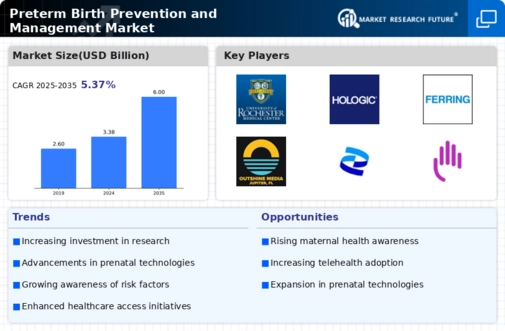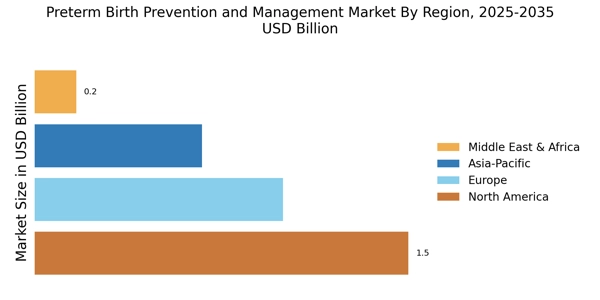Advancements in Medical Technology
Technological advancements play a pivotal role in shaping the Preterm Birth Prevention and Management Market. Innovations such as telemedicine, wearable health devices, and advanced diagnostic tools are enhancing prenatal care and monitoring. For instance, the integration of artificial intelligence in predicting preterm labor has shown promising results, potentially reducing the incidence of preterm births. Furthermore, the development of mobile applications that provide expectant mothers with personalized health information and reminders is gaining traction. These technological solutions not only improve patient outcomes but also streamline healthcare processes, thereby driving the growth of the Preterm Birth Prevention and Management Market. As technology continues to evolve, its impact on this market is expected to expand significantly.
Rising Incidence of Preterm Births
The increasing incidence of preterm births is a critical driver for the Preterm Birth Prevention and Management Market. Recent data indicates that approximately 15 million infants are born preterm each year, which represents a significant public health challenge. This rise can be attributed to various factors, including maternal age, lifestyle choices, and underlying health conditions. As awareness of the complications associated with preterm births grows, healthcare providers and policymakers are prioritizing preventive measures and management strategies. This heightened focus is likely to stimulate demand for innovative solutions and interventions within the market, thereby fostering growth and development in the Preterm Birth Prevention and Management Market.
Growing Awareness of Maternal Health
The growing awareness of maternal health issues is significantly influencing the Preterm Birth Prevention and Management Market. As more individuals recognize the importance of prenatal care and its impact on birth outcomes, there is a corresponding increase in demand for services and products aimed at preventing preterm births. Educational campaigns and community outreach programs are effectively disseminating information about risk factors and preventive measures. This heightened awareness is likely to lead to increased utilization of healthcare services, including regular check-ups and screenings, which are essential for early detection and management of potential complications. Consequently, this trend is expected to drive growth in the Preterm Birth Prevention and Management Market.
Focus on Multidisciplinary Care Approaches
The emphasis on multidisciplinary care approaches is emerging as a vital driver for the Preterm Birth Prevention and Management Market. Collaborative care models that involve obstetricians, pediatricians, nutritionists, and mental health professionals are gaining traction. This holistic approach addresses the various factors contributing to preterm births, including physical, emotional, and social determinants of health. By fostering communication and coordination among healthcare providers, these models enhance the quality of care and improve outcomes for mothers and infants. As healthcare systems increasingly adopt multidisciplinary strategies, the demand for integrated services and solutions within the Preterm Birth Prevention and Management Market is likely to rise, promoting further advancements in this field.
Increased Government Initiatives and Funding
Government initiatives aimed at reducing preterm births are emerging as a significant driver for the Preterm Birth Prevention and Management Market. Various countries are implementing programs that focus on maternal health education, access to prenatal care, and research funding. For example, initiatives that promote awareness about the risks associated with preterm births and the importance of early intervention are gaining momentum. Additionally, increased funding for research into the causes and prevention of preterm births is likely to yield new insights and solutions. This proactive approach by governments not only enhances public health outcomes but also stimulates investment in the Preterm Birth Prevention and Management Market, fostering innovation and development.


















Leave a Comment